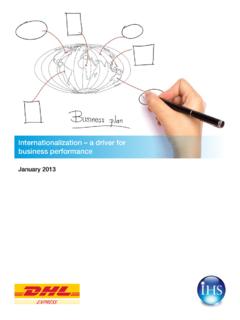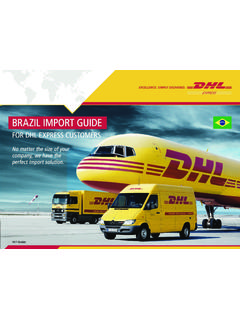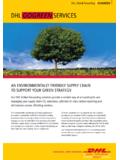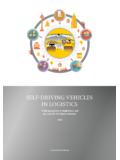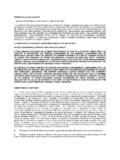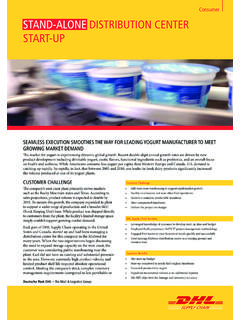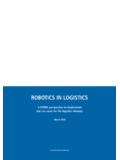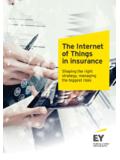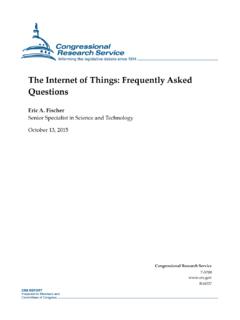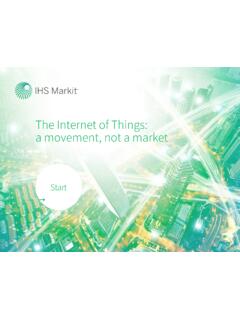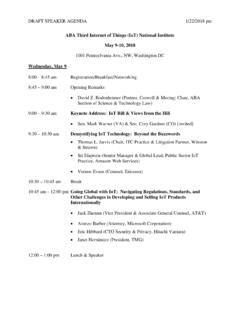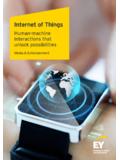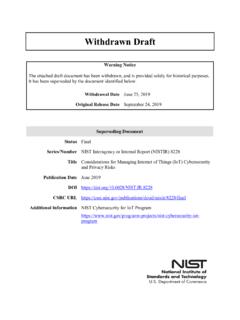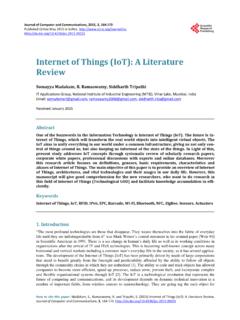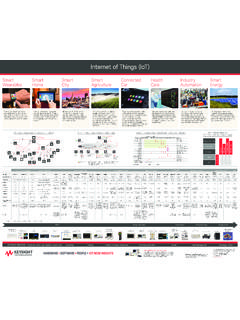Transcription of INTERNET OF THINGS IN LOGISTICS - DHL | Global
1 INTERNET OF THINGS . IN LOGISTICS . A collaborative report by DHL and Cisco on implications and use cases for the LOGISTICS industry 2015. DHL Trend Research | Cisco Consulting Services PUBLISHER. Represented by Matthias Heutger Senior Vice President DHL Customer Solutions & Innovation 53844 Troisdorf, Germany PROJECT DIRECTORS. Dr. Markus K ckelhaus James Macaulay DHL Trend Research Cisco Consulting Services PROJECT MANAGEMENT AND EDITORIAL OFFICE. Gina Chung Lauren Buckalew DHL Trend Research Cisco Consulting Services AUTHORS. James Macaulay, Lauren Buckalew, Gina Chung Preface 1. PREFACE. We at DHL and Cisco are excited to share this new trend report DHL and Cisco share a belief in the potential of IoT to revolutio- with readers from the LOGISTICS industry on a topic that fires the nize business processes across the entire value chain, and parti- imaginations of both our companies: the INTERNET of THINGS (IoT).
2 Cularly the experiences of our customers. In our collaboration, we will explore a few of the many innovations presented by IoT, IoT presents a unique technology transition that is impacting all and their application to the LOGISTICS industry. We hope you find our lives and will have huge implications for the business of logis- the journey illuminating. tics. As we move from 15 billion connected devices today to some 50 billion by 2020, and embed sensor technology and analytics Yours sincerely, throughout our organizations, companies will enjoy unpreceden- ted visibility into operations, enabling new sources of value. This visibility, in turn, will transform how LOGISTICS providers make decisions, including about how goods are stored, monitored, rou- ted, serviced, and delivered to customers, as well as operational health and safety practices. Furthermore, the proliferation of IoT for our homes, work environments, cities and even ourselves (with the emergence of wearable technologies and biomedical sensors) creates oppor- tunities for new business models in LOGISTICS .
3 We believe there is hidden value yet to be realized. This trend report aims to deepen readers' understanding of IoT, James Macaulay Dr. Markus K ckelhaus covering three main issues: Cisco Consulting Services DHL Trend Research What is the INTERNET of THINGS , and why is it a big deal? What are some of the leading practices and applications of IoT that are generating value across sectors? What are some of the key use cases for IoT in the LOGISTICS industry specifically, and what will be their implications? 2 Table of Contents Preface .. 1. 1 Understanding the INTERNET of THINGS .. 3. Introduction: Connecting the Unconnected .. 3. The INTERNET of Everything vs. IoT .. 5. IoT Impacts on LOGISTICS .. 7. 2 IoT Best Practices .. 8. Operational Efficiency .. 8. Safety and Security .. 10. Customer Experience .. 12. New Business Models .. 13. 3 IoT in LOGISTICS .. 14. Use Cases Warehousing Operations.
4 14. Use Cases Freight Transportation .. 18. Use Cases Last-mile Delivery .. 21. Success Factors for IoT in LOGISTICS .. 25. Outlook .. 26. Sources .. 27. Understanding the INTERNET of THINGS 3. 1 UNDERSTANDING THE INTERNET OF THINGS . Introduction: Connecting the Unconnected In today's society, the INTERNET is often considered a given due to the simplest way to think of IoT is to consider it as the networked its ubiquitous presence and accelerating influence on the ways in connection of physical objects. which we live, work, and communicate with one another. But how did the INTERNET get so large so quickly, and what role will it play in With the advent of IoT, INTERNET connections now extend to physi- the future? cal objects that are not computers in the classic sense and, in fact, serve a multiplicity of other purposes (see Figure 1). A shoe, for The INTERNET has undergone numerous stages of development, example, is designed to cushion the foot while walking or running.
5 Dating back to the founding days of ARPANET, the first TCP/IP net- A street light illuminates a road or sidewalk. A forklift is used to work from which today s INTERNET evolved. Throughout these stages, move pallets or other heavy items. None of these have traditionally the INTERNET has fundamentally been about connecting computers. been connected to the INTERNET they did not send, receive, pro- These computers, of course, continue to evolve in parallel with the cess or store information. Nonetheless, there is information latent build-out of the INTERNET , with significant developments in PCs, in all of these items and their use. When we connect the unconnec- laptops, tablets, smartphones, and more. Regardless of the many ted when we light up dark assets vast amounts of informati- different form factors and computing architectures, the INTERNET on emerge, along with potential new insights and business value.
6 Essentially revolved around connecting these devices whose sole rea- son to exist was to send, receive, process, and in most cases store in- A connected shoe can tell its owner (or a researcher, or a manu- formation. Until relatively recently, the INTERNET has been composed facturer) the number of footfalls in a given period of time, or the entirely of computers connected to one another over the network. force with which the foot strikes the ground. A connected street light can sense the presence of cars, and provide information to Today this is no longer the case. We have entered a unique period drivers or city officials for route planning and to optimize the flow in the life of the INTERNET the INTERNET of THINGS (IoT). IoT is not of traffic. A connected forklift can alert a warehouse manager to an an entirely new concept, having originated in the early 2000s with impending mechanical problem or safety risk, or be used to create the work of MIT's AutoID Lab.
7 While definitions vary, perhaps 1. greater location intelligence of inventory in the warehouse. Figure 1: The Connected Home and Consumer 1. 4 Understanding the INTERNET of THINGS To light up such dark assets, IoT encompasses a diverse array of puters, consumer electronics, and communication devices ( , different technologies including wireless local ( , Bluetooth, smartphones); appliances; physical materials in the home ( , RFID, Zigbee, Wi-Fi), mesh network, and wide area connections thermostat, plumbing); clothing and wearable devices; vehicles ( , 3G, LTE), as well as wired connections. Increasingly, IoT and much more. By 2020, Cisco estimates there will be more than represents the convergence of information technology (IT) and 50 billion devices connected to the INTERNET . By that time, compu- so-called operational technology (OT). OT is characterized by ters (including PCs, tablets, and smartphones) will represent just more specialized, and historically proprietary, industrial network 17 percent of all INTERNET connections; the other 83 percent will protocols and applications that are common in settings such as result from IoT, including wearables and smart-home plant floors, energy grids, and the like.
8 While this may seem like a low rate of current penetration, Of course, IoT also includes more consumer-oriented devices, IoT deployments have skyrocketed in recent years. According embedded technologies, and apps. An important element of this to Zebra Technologies, in a study conducted with Forrester is the incorporation of controllers and actuators (Arduino is a Research, enterprise IoT deployments have grown by 333 percent well-known example), so that an action taken in the digital world, since 2012. According to the survey, 65 percent of respondents such as a user clicking a link in an application, can result in a had deployed IoT technologies in the enterprise in 2014, compa- corresponding action in the physical world ( , an alarm sounds, red to only 15 percent in Although technical and public a lever flips, an assembly line comes to a halt). policy issues persist, many factors contribute to the accelerating deployment of IoT capabilities.
9 These include progress toward However, we are only at the beginning of the IoT revolution. So common IP-led standards; the introduction of IPv6 (which far, less than one percent of all physical objects that could be resolves the constraint on the number of available IP addresses connected to the INTERNET are currently connected. In numbers, for connected devices); the proliferation of wireless connectivity;. that means of the roughly trillion items on earth that could improved battery life; device ruggedization and new form fac- benefit from an IP address, just under 15 billion are connected to tors; open innovation models such as Kickstarter and Indiegogo, the INTERNET The average consumer in a developed nation as well as the so-called maker movement; and the declining costs is surrounded by dozens of connectable items. These include com- of technology, following Moore's Law. Figure 2: IoE, the Networked Connection of People, Process, Data, and Things5.
10 2. 3. Strategy Analytics, Connected World: The INTERNET of THINGS and Connected Devices in 2020, 9 October 2014. 4. IoT in the Enterprise Up Three-Fold, Study Finds, Network World, November 24, 2014. 5. Cisco Consulting Services, 2014. Understanding the INTERNET of THINGS 5. The INTERNET of Everything vs. IoT. As critical as IoT is in connecting the unconnected, it is only part Current calculations estimate that IoE represents $19 trillion in of the story. Along with physical objects, people and intangible Value at Stake globally over the next Value at Stake can THINGS must also be connected in new and better ways. IoT is be understood as the new net profits created as a result of IoE ( , a vital enabler of certain types of connection that together make from markets that could not have existed before), as well as the up what Cisco refers to as the INTERNET of Everything (IoE). IoE migration of profits from losers to winners as a result of IoE-led connections can be machine-to-machine (M2M); machine-to- market dynamics.
